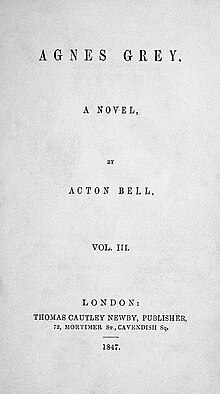Agnes Grey

The first edition title page of Agnes Grey. Wuthering Heights by Emily Brontë took up the first two volumes of the edition.
|
|
| Author | Anne Brontë |
|---|---|
| Country | United Kingdom |
| Language | English |
| Genre | Victorian literature |
|
Publication date
|
December 1847 |
| Followed by | The Tenant of Wildfell Hall |
Agnes Grey is the debut novel of English author Anne Brontë (writing under the pen name of Acton Bell), first published in December 1847, and republished in a second edition in 1850. The novel follows Agnes Grey, a governess, as she works within families of the English gentry. Scholarship and comments by Anne's sister Charlotte Brontë suggest the novel is largely based on Anne Brontë's own experiences as a governess for five years. Like her sister Charlotte's novel Jane Eyre, it addresses what the precarious position of governess entailed and how it affected a young woman.
The choice of central character allows Anne to deal with issues of oppression and abuse of women and governesses, isolation and ideas of empathy. An additional theme is the fair treatment of animals. Agnes Grey also mimics some of the stylistic approaches of bildungsromans, employing ideas of personal growth and coming to age, but representing a character who in fact does not gain in virtue.
The Irish novelist George Moore praised Agnes Grey as "the most perfect prose narrative in English letters," and went so far as to compare Anne's prose to that of Jane Austen. Modern critics have made more subdued claims admiring Agnes Grey with a less overt praise of Brontë's work than Moore.
The genesis of Agnes Grey was attributed by Edward Chitham to the reflections on life found in Anne's diary of 31 July 1845.
It is likely that Anne was the first of the Brontë sisters to write a work of prose for publication, although Agnes Grey, Wuthering Heights, and Jane Eyre were all published within the same year: 1847. Anne's novel was eventually published by Thomas Newby in a triple-volume format: Emily's Wuthering Heights made up the first two volumes (by virtue of it being the longer), while Agnes Grey made up the third.
The original edition of Agnes Grey, published in 1847, had numerous orthographic, punctuation, and other issues attributed to neglect by the publisher Newby. However, the second edition, published in 1850, had many changes after the careful editing of Charlotte Brontë.
...
Wikipedia
